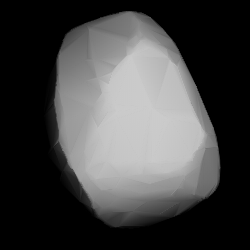164 Eva is a main-belt asteroid that was discovered by the French brothers Paul Henry and Prosper Henry on July 12, 1876, in Paris. The reason the name Eva was chosen remains unknown, though Karl Ludwig Littrow suspected a "worldly origin" ("Mit dem Namen könnten wir wie bei Miriam wieder den biblischen Boden zu betreten glauben, wenn wir bei diesem Entdecker nicht an Taufen weltlichen Ursprungs gewöhnt wären").[6] The orbital elements for 164 Eva were published in 1877 by American astronomer Winslow Upton.[7] It is categorized as a C-type asteroid and is probably composed of primitive carbonaceous chondritic materials.
 3D convex shape model of 164 Eva | |
| Discovery | |
|---|---|
| Discovered by | P. P. Henry |
| Discovery site | Paris |
| Discovery date | 12 July 1876 |
| Designations | |
| (164) Eva | |
| Pronunciation | /ˈiːvə/[1] |
Named after | Unknown |
| A876 NA | |
| Main belt | |
| Orbital characteristics[2] | |
| Epoch 31 July 2016 (JD 2457600.5) | |
| Uncertainty parameter 0 | |
| Observation arc | 118.93 yr (43438 d) |
| Aphelion | 3.5444 AU (530.23 Gm) |
| Perihelion | 1.7188 AU (257.13 Gm) |
| 2.6338 AU (394.01 Gm) | |
| Eccentricity | 0.34577 |
| 4.27 yr (1561.2 d) | |
| 219.5472° | |
| 0° 13m 50.128s / day | |
| Inclination | 24.4564° |
| 76.8519° | |
| 283.9561° | |
| Earth MOID | 0.882286 AU (131.9881 Gm) |
| Jupiter MOID | 2.44116 AU (365.192 Gm) |
| TJupiter | 3.191 |
| Physical characteristics | |
| Dimensions | 104.87±1.9 km[2] 101.77 ± 3.61 km[3] |
| Mass | (9.29 ± 7.76) × 1017 kg[3] |
Mean density | 1.68 ± 1.41 g/cm3[3] |
Equatorial surface gravity | 2.249 cm/s (mean) |
Equatorial escape velocity | 4.857 cm/s (mean) |
| 13.66 h (0.569 d)[2] 13.672 h[4] | |
| 0.0447±0.002 | |
| Temperature | 170 K (mean) |
| C | |
| 8.89,[2] 8.84[5] | |
Photometric observations of this asteroid at the Palmer Divide Observatory in Colorado Springs, Colorado, during 2008 gave a light curve with a period of 13.672 ± 0.003 hours and a small brightness variation of 0.04 ± 0.01 in magnitude. This is consistent with a previous study reported in 1982 that listed a period estimate of 13.66 hours.[4]
Between 2000 and 2021, 164 Eva has been observed to occult fourteen stars.
With a perihelion of 1.718 AU 164 Eva is the closest asteroid over 100 kilometers to approach the orbit of Mars. Its closest approach is about 0.05 AU or about 19.5 lunar distances.[8]
References
edit- ^ "Eva". Dictionary.com Unabridged (Online). n.d.
- ^ a b c d Yeomans, Donald K., "164 Eva", JPL Small-Body Database, archived from the original on 4 March 2019, retrieved 12 May 2016.
- ^ a b c Carry, B. (December 2012), "Density of asteroids", Planetary and Space Science, 73 (1): 98–118, arXiv:1203.4336, Bibcode:2012P&SS...73...98C, doi:10.1016/j.pss.2012.03.009. See Table 1.
- ^ a b Warner, Brian D. (January 2009), "Asteroid Lightcurve Analysis at the Palmer Divide Observatory: 2008 May - September", The Minor Planet Bulletin, 36 (1): 7–13, Bibcode:2009MPBu...36....7W.
- ^ Warner, Brian D. (December 2007), "Initial Results of a Dedicated H-G Project", The Minor Planet Bulletin, 34 (4): 113–119, Bibcode:2007MPBu...34..113W.
- ^ Schmadel, Lutz D. (2012), Dictionary of Minor Planet Names, Springer, pp. 28, 1341, ISBN 978-3642297182.
- ^ Upton, Winslow (July 1877), "Elements of (164) Eva", Astronomische Nachrichten, 90 (6): 85–86, Bibcode:1877AN.....90...85U, doi:10.1002/asna.18770900605.
- ^ NASA.gov
External links
edit- Lightcurve plot of 164 Eva, Palmer Divide Observatory, B. D. Warner (2008)
- Asteroid Lightcurve Database (LCDB), query form (info Archived 16 December 2017 at the Wayback Machine)
- Dictionary of Minor Planet Names, Google books
- Asteroids and comets rotation curves, CdR – Observatoire de Genève, Raoul Behrend
- Discovery Circumstances: Numbered Minor Planets (1)-(5000) – Minor Planet Center
- 164 Eva at AstDyS-2, Asteroids—Dynamic Site
- 164 Eva at the JPL Small-Body Database